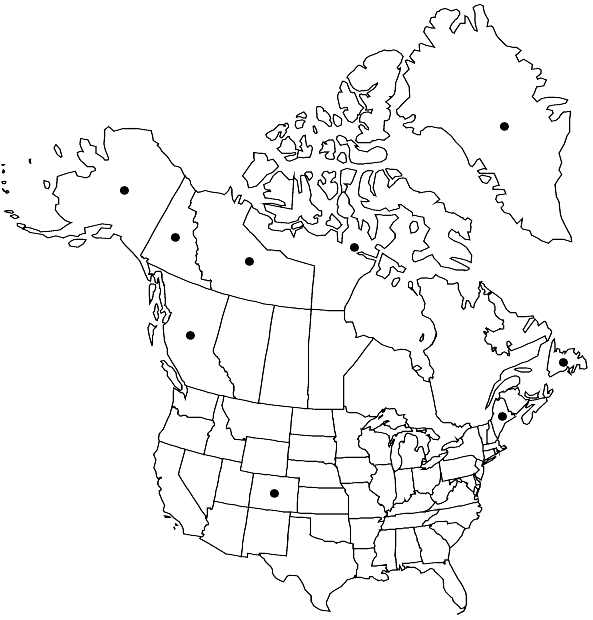Tortella tortuosa var. arctica
in B. A. Fedtschenko, Fl. Aziat. Ross. 13: 160. 1918,.
Plants red-green, appearing black proximally, densely foliose with a thick apical coma, leaf bases hidden. Stems appearing atomentose but tomentum hidden in the bases of branch innovations. Leaves densely disposed on stem or in dense annual whorls distinctly separated by less foliose regions, terminating in a thick multi-branched comal tuft, tips present and not fragile, intact; leaves often strongly squarrose-recurved when wet, plane, not undulate; proximal laminal cells thick-walled and brownish, intergrading in shape and size with the distal cells, which are often nonpapillose in the area of merger; leaves broadly concave in section; leaf cross section with cells in one layer beside the costa, the lamina uniformly 1-stratose; costa at midleaf exposed adaxially by as much as four stereid cells, the costa always differentiated into guide cells, stereids and epidermal cells, adaxial stereid layer never disappearing toward the apex, adaxial epidermal layer typically absent apically in a medial groove to 2 stereid cells in width.
Habitat: Depressions in mesic to wet tundra, soil over limestone and sandstone, below snowfields, hillside and mountain seepage and seepage channels, bordering streams and ponds, wet rock surfaces, fens, wet frost boils, frequently on ridges in the wetter areas, Carex-Eriophorum meadows, Dryas communities, Cassiope heaths, wet sandy Eriophorum triste meadow
Elevation: low to high elevations (0-3600 m)
Distribution

Greenland, B.C., Nfld. and Labr. (Nfld.), N.W.T., Nunavut, Yukon, Alaska, Colo., Maine, Asia (China, Russia in Siberia).
Discussion
Variety arctica is easily distinguished by the leaf cells extremely thick-walled and obscured by massive papillae, and the proximal cells grading gradually into the distal laminal cells. However, intermediates in anatomical characters are abundant in more temperate situations in a zone between north boreal regions and the Arctic (extreme north). Intermediate specimens are also found at higher elevations in the south Boreal zone and in wet continental (coastal) margins in the extreme northern Arctic and Greenland. The most distinctive representative specimens are a blackened brick-red, with very long stems, and so densely foliose with rigid leaves as to appear to felt the substrate on which they grow with woolly mats. However, in sites that have more temperate conditions, especially at the southern limit of its range, the species varies such that the stems may be less foliose, hence less dense except in innovating whorls and at the apex, the dry leaves become more contorted at the stem apex, the red color subsides toward the yellow-green of Tortella tortuosa, the sclerodermis recedes to resemble that of the typical variety and the distal laminal cells have thinner walls, tiny papillae and are strikingly set off from the proximal cells which are thin and lax, clear and free of papillae. Such plants then have more tortuous leaves when dry. In such specimens, one must rely for identification on the relatively denser habit, at least at the stem apex, the leaf shape, with its broader leaf base and more abruptly contracted, more rigid distal lamina, the tubular or canaliculate leaf cross section (not keeled) and the tomentum hidden in the bases of the leaves (rather than exposed). Although T. tortuosa var. arctica may replace var. tortuosa in the high Arctic, the former does range to the south into Maine and Colorado. In latitudes where the two varieties overlap, distinction becomes highly problematical. The sclerodermis of var. arctica can be a thick rind around the central cylinder.
Selected References
None.